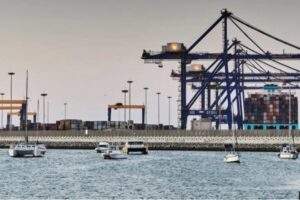By Wesam Bahrani
Tensions are running high in the Red Sea amid the Yemeni military’s attacks on vessels heading toward the occupied Palestinian territories and the subsequent formation of a US-led maritime coalition.
American Navy already has an extensive presence in the Persian Gulf waters, thousands of miles away from American borders, as well as in the vital Red Sea and close to the strategic Bab al-Mandab Strait.
Since the Israeli regime launched its genocidal war on the besieged Gaza Strip on October 7, Americans have come out openly and brazenly in support of the regime, providing it with a large cache of munitions as well as political support.
What Washington perhaps didn’t take into consideration was the historical stance of Yemen’s Ansarullah resistance movement viz a viz Palestine and the growing cohesion in the Axis of Resistance.
Pentagon certainly didn’t expect Yemenis to stand up and refuse to be mute spectators to the genocide unfolding in Gaza, carrying out a string of attacks on Israel-linked ships and imposing an embargo on vessels trying to dock in Israeli-occupied Palestinian ports.
What has shocked the American elites further is the fact that Yemenis have been successful in enforcing the embargo and forcing major shipping companies to avoid the Red Sea and divert their ships to other routes, stamping their authority on the strategic body of water.
Essentially, this has made the waterway, through which much of the world’s oil is shipped from Asia to Europe, extremely costly, raising insurance prices while adding 12 extra days to reach their points of destination.
Yemeni military’s measures have not been based on empty rhetoric, but real military action in support of Palestinians. They have demonstrated what solidarity and support in practical terms entails.
What Washington initially did was a lot of talking with “partners” in the region to avoid the war from “widening”, as was warned by many regional players.
Never in a million years did the US believe the war could potentially expand to Yemen.
The question is if the US has the most advanced aircraft carriers and carrier strike groups in the world, why does it need a ten-nation alliance to combat the threat from the military of a poor Arab nation?
And more importantly, what type of alliance is this?
Why not send the US Secretary of Defense to Bahrain and announce a regional alliance involving countries such as Saudi Arabia and Egypt?
That would make it slightly more legal in the eyes of the international community since militarizing a part of the world without a UN Security Council vote is unlawful.
The first stumbling block for the US is that Saudi Arabia and Egypt, who also share parts of the Red Sea, have refused to join the anti-Yemen alliance. Both countries have greater naval forces and military capabilities than Yemen and are geographically larger.
For Riyadh, it is a sign that the Arab kingdom is not interested, at this current stage, in any normalization deal with the Israeli regime and it has already seen what the Yemenis are capable of.
And for Saudi Arabia to stand in the way of the biggest movement pressuring the Israeli regime to end its war on Gaza would not be the best public relations (PR) move for Riyadh.
Lest we forget, Saudi Arabia as well as the United Arab Emirates fought an eight-year war against the Yemeni resistance, backed by the US, and surely doesn’t want a return to Aramco 2019.
And let’s not forget Egypt did not take part in the regional coalition put together by the Saudis to fight Ansarulllah in March 2016, as it rightly observed, at the time, that this war would have no end in sight.
Forming a US-led alliance in the Red Sea didn’t happen overnight.
Washington has spent the best part of the past month indirectly negotiating with Ansarullah via Oman to end its attacks on Red Sea Israeli-linked targets in return for a list of favors.
These include the full reopening of Sana’a airport, Hodeidah port, the payment of civil servant salaries as well as other incentives.
The Yemeni group rejected all of them and has publicly and privately stated that it will end the Red Sea embargo against vessels that serve Israeli interests only when the massacre of civilians ends in Gaza.
Yemen did not come from another planet, or Eastern Asia or Africa. It is one of the countries that share the Red Sea and has a lawful right to carry out legitimate measures in waters near its borders.
The second stumbling block for the US maritime alliance is that it cannot get any Islamic states on board, and no Arab states except Bahrain.
Whether Bahrain has the sovereignty to make its own decisions or the US takes those decisions for the tiny Arab kingdom is a subject of debate for another day.
What is clear is that Bahrain does not have a naval force capable of providing anything to the table.
For America, it would have been ideal to have regional countries in its alliance to publicly try and distance itself from the Israeli regime.
This was of utmost importance for Washington to try and portray itself as not taking sides with the Israeli regime and limiting the issue to Red Sea maritime traffic.
But it has failed to do so.
Where are the Islamic countries in this alliance? There are none, which constitutes another failure for the US and its Western allies who seek to take on Yemenis.
Even the separatist forces in southern Yemen, who have been fighting the Ansarullah resistance movement, have not objected to its attacks on Israel-linked ships.
The countries that have joined the so-called “US-led multinational” naval force in the Red Sea include the UK, Bahrain, Canada, France, Italy, Netherlands, Norway, the Seychelles and Spain.
Why use the term “multinational” when it is anything but multinational? This is a sign of both American weakness and desperation. US warships also have been the targets of Yemeni drones and missiles.
Other frigates traveling to the region will not know where Yemeni missiles and drones are coming from and will be on constant awareness to intercept them.
That doesn’t sound like shipping companies are returning to the Red Sea any time soon. The Pentagon is sensitive as to where this development can lead.
Will it have any immediate impact on securing the strategic waterway for commercial shipping to return to the Israeli regime? Not in this lifetime. Ansarullah is definitely not stepping back from its position.
Ansarallah spokesperson and top negotiator Mohammed Abdelsalam was quoted as saying on Tuesday that naval operations in the Red Sea “are in full swing”, adding that “not 12 hours would pass without an operation,” signaling the resoluteness of Yemen.
Any country that moves against Yemen will have its ships targeted in the Red Sea, Mohammed Ali al-Houthi, a member of the Supreme Yemeni Political Council, made the comments on Al-Alam TV.
The US that called for the war on Gaza not to be “extended” in the region is now heavily militarizing the region, in a move that will eventually turn out to be counter-productive.
Secondly, the oil price will not rise and hover at around $75 as it did on Monday but will rise to $100 per barrel or potentially $200 to $300 per barrel.
In essence, the US does not want to be blamed for this rise or any other collateral damage for what US Defense Secretary Lloyd Austin announced in Bahrain. This is where the UK, Bahrain, Canada, France, Italy, Netherlands, Norway, the Seychelles and Spain come into play and essentially share the blame.
Also showing US weakness today and its need for countries to join its alliance reflects the reality of just how much the US and the Israeli regime are isolated in the international arena.
This was reflected in the UN General Assembly vote, where 153 member states voted in favor of an immediate humanitarian ceasefire in the Israeli war on Gaza and 10 voted against it, with 23 abstaining.
If you put the abstentions aside, that means 153 states versus 10.
Among those ten countries were the US, the Israeli regime, Austria, and Paraguay. Joining them were Czechia, Guatemala, Liberia, Micronesia, Nauru, and Papua New Guinea.
That’s how isolated the US and its illegitimate offspring in Tel Aviv are in their war on Gaza.
And now it wants to take on Yemen, despite trying and failing to do so since March 2015.
Wesam Bahrani is an Iraqi journalist and commentator.
(The views expressed in this article do not necessarily reflect those of Press TV.)




